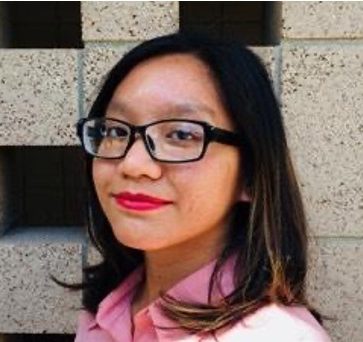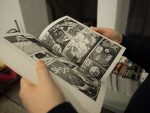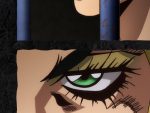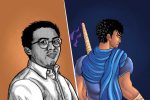“Tower of God” is an ongoing Korean webtoon created by Lee Jong-hui, also known by his pen-name, SIU (Slave. In. Utero). The webtoon was officially published in 2010 by Naver Webtoon before it gained popularity. LINE Webtoon started an official English translation in 2014. With over 19.7 million likes, “Tower of God” is the fourth most popular webtoon on the publishing portal within the fantasy genre. Just recently, in February 2020, it was officially confirmed that LINE Webtoon and Crunchyroll will collaborate and produce an anime adaptation. The anime is set to premiere in spring of 2020.
“Tower of God” tells the story of a boy named Twenty Fifth Baam (Baam can mean “night” or “chestnut”) who spends his life imprisoned underground with virtually no human contact other than a girl named Rachel. One day, Rachel leaves to enter the mysterious “Tower” to chase her dream of seeing the starry night sky. With his world gone, Baam chases after her, entering the structure as well. He faces challenges on each floor, navigating his way through a new world and its strange inhabitants.
https://www.instagram.com/tower.of.god/p/4sXxUPC03g/?hl=en
Here are some reasons why you should binge-read 464 chapters (and counting) in one go:
Beautiful Art Style
SIU’s art is beautiful. From the first season, he is talented at conveying the mood of a scene through color — an advantage that webtoon artists have over manga, which is typically drawn in black and white. His art also improves as the season progresses. If you compare the current season — the third season — to the first season, there’s more texture and detail in each panel.
In addition, the depth and detail in the background design of each scene is astounding. SIU plays with the texture of the background as a way of world-building.
The “Tower of God” creator pays attention to character design to such an extent that it’s very easy for readers to glean a character’s personality from their hairstyle or from their clothing choices. For example, Khun Aguero Agnes, who’s one of Baam’s teammates in the Tower, has dark blue eyes and desaturated blue hair. While obnoxious colors are often ways for artists to denote main characters, Khun’s style choice identifies him as part of the Khun family, one of the Ten Great Families in the Tower.
SIU also takes full advantage of the scrolling format of webtoons. I always got the sense of motion in the fighting scenes and the characters’ movements as I read “Tower of God.”
Dramatic Conflict
In “Tower of God,” people climb “The Tower” for their goals and ambitions. Everything, including wealth, honor and power, can be attained through the structure.
Baam’s goal to confront Rachel while in the mysterious building hides his internal desire to return to simpler times before the two entered. At one point, he tracks down his only companion; however, the protagonist is unwilling to reconcile that Rachel’s wishes contradict his own. She wishes to continue to climb the “Tower,” even at the expense of Baam. The two characters’ conflicting goals drive the plot in “Tower of God.”
On a larger scale, politics within “The Tower” also move the plot forward. As readers, we get to see how the conflict between Baam and Rachel tangles with political authorities and organizations, such as King Jahad, the self-proclaimed King of the Tower; FUG, a criminal organization against the King; and wildcards called Irregulars, people who entered the Tower without invitation from the Tower itself, such as Baam and Rachel.
Compelling Characters
What makes the webtoon comic an addictive read is the cast. SIU creates the characters, each with their own personality, goals and thought processes. He does not let it stifle the plot; instead, it drives the story forward with more complexity. For example, Baam values Rachel more than climbing up the “Tower.” However, she sees him as an obstacle in her journey up the structure. The creator allows the tension between the two protagonists to build in such a way that it becomes a clash of ideology and beliefs.
The supporting characters in “Tower of God” are also fleshed out like Baam and Rachel — each having their own motivations. I love reading how supporting character arcs develop as they evolve into their own individual, such as Yeo Miseng. A young girl who entered the Tower with her older sister Yeo Goseng, she is seen as shy and weak. Miseng is a character who readers would consider cannon fodder for plot development. However, she matures and grows into her powers with her own goals in mind, standing on her own rather than clinging to her sister’s side.
While most Shonen manga illustrate good and evil as clear-cut, SIU’s webtoon dwells in the ambiguous gray in-between. It’s not uncommon to see a character who’s introduced as an antagonist in a previous episode before you see them siding with the protagonist. Humans can be easily swayed with their desires — a characteristic that the creator is talented at illustrating through his “Tower of God” cast. SIU refrains from showing characters converting to Baam’s side — the “good side.” Instead, the fictional individuals switch allegiances because their interests happen to align with Baam at that moment, which makes the story interesting when their interests clash again.
Well-Developed World-Building
I love the amount of detail put into building the world within “Tower of God.” “The Tower” is the only world that the inhabitants know of. Little is known of the outside world. Everyone in the structure requires an energy called Shinsoo — similar to chakra in “Naruto” — to breathe.
In order to reach the top, both Regulars (people who choose to climb “The Tower”) and Irregulars must climb 134 floors and pass each floor’s test. Each level has its own staff, including the Administrator, who controls Shinsoo flow on the floor, and the Ruler, someone who rules the tier under the permission of the Administrator. Those who reach the 134th floor become Rankers. Competition continues as Rankers aim for higher Rankings and more power.
SIU slowly establishes the political hierarchy within “The Tower,” in which King Jahad rules as the monarch. Under him are the 10 Great Families, whose leaders climbed the structure with King Jahad as his teammates. With power comes corruption. Through Baam’s adventures, we slowly see how deeply entrenched it is within the system.

















